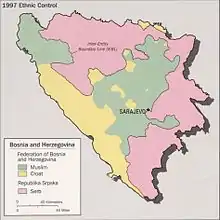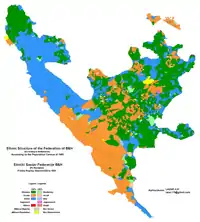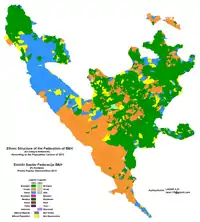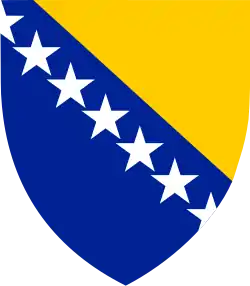Federation of Bosnia and Herzegovina
The Federation of Bosnia and Herzegovina[4] is one of the two entities that compose the State of Bosnia and Herzegovina, the other being Republika Srpska. The Federation of Bosnia and Herzegovina consists of 10 autonomous cantons with their own governments and legislatures.
Federation of Bosnia and Herzegovina Federacija Bosne i Hercegovine Федерација Босне и Херцеговине | |
|---|---|
_-_colored.svg.png.webp) Location of the Federation of Bosnia and Herzegovina (yellow) within Bosnia and Herzegovina. Brčko District is shown in pale green.a | |
| Sovereign state | |
| Washington Agreement | 18 March 1994 |
| Recognized as part of Bosnia and Herzegovina | 14 December 1995 |
| Capital and largest city | Sarajevo 43°52′N 18°25′E |
| Official languages[1] | |
| Ethnic groups (2013) | |
| Government | Federated state |
| Marinko Čavara | |
| Fadil Novalić | |
| Legislature | Parliament |
| House of Peoples | |
| House of Representatives | |
| Area | |
• Total | 26,110.5 km2 (10,081.3 sq mi) |
| Population | |
• 2013 census | 2,219,220[2] |
• Density | 91/km2 (235.7/sq mi) |
| Currency | Convertible markb (BAM) |
| Time zone | UTC+01:00 (CET) |
| UTC+02:00 | |
| Calling code | +387 |
| a Formally, Brčko District is held in condominium by both parts of Bosnia and Herzegovina (namely, the Federation of Bosnia and Herzegovina and Republika Srpska). De facto, however, it is a third entity, as it has the same powers as the Federation and Republika Srpska and is under the direct sovereignty of BiH.[3] b Latin version | |
The Federation was created by the 1994 Washington Agreement, which ended the Croat–Bosniak war within the Bosnian war, and established a constituent assembly that continued its work until October 1996.
The Federation has a capital, government, president, parliament, customs and police departments and two postal systems. From 1996 until 2005 it had its own army, the Army of the Federation of Bosnia and Herzegovina, later merged in the Armed Forces of Bosnia and Herzegovina. The capital and largest city is Sarajevo with 438,443 inhabitants,[5] out of a total population of 688,354 in its metropolitan area.
History

The basis for the creation of the Federation of Bosnia and Herzegovina were laid down by the Washington Agreement of March 1994.[6] Under the agreement, the combined territory held by the Army of the Republic of Bosnia and Herzegovina and the Croatian Defence Council forces was to be divided into ten autonomous cantons along the lines of the Vance-Owen plan. The cantonal system was selected to prevent dominance of one ethnic group over another. However, much of the territory Croats and Bosniaks claimed for their Federation was at that point still controlled by the Bosnian Serbs.
The Washington Agreement was implemented during the spring of 1994, by convoking a Constitutional Assembly, which on June 24 adopted and proclaimed the Constitution of the Federation of Bosnia and Herzegovina.[7]
In 1995, Bosnian government forces and Bosnian Croat forces of the Federation of Bosnia and Herzegovina defeated forces of the Autonomous Province of Western Bosnia, and this territory was added to the federation (Una-Sana Canton).
Post-war
By the Dayton Agreement of 1995 that ended the four-year war, the Federation of Bosnia and Herzegovina was defined as one of the two entities of Bosnia and Herzegovina, comprising 51% of country's area, alongside Republika Srpska. Cantons and federal structure were built rather slowly after the war. Separatist Croat Herzeg-Bosnia institutions existed and functioned parallel to Federation ones up until 1996–97, when they were phased out. On 8 March 2000, the Brčko District was formed as an autonomous district within Bosnia and Herzegovina and it was created from part of the territory of both Bosnian entities. Brčko District is now a condominium that belongs to both entities.
In 2001–2002, the Office of the High Representative (OHR) imposed amendments to the Federation's Constitution and its electoral law, in compliance with the decisions of the Constitutional Court of Bosnia and Herzegovina on the political equality of the three costituent peoples (U-5/98).[8] This triggered the grievances of Bosnian Croats, who claimed they were deprived of their rights to representation as Bosniaks had come to control the majority in the upper house as well.[9] Dissatisfied Croat politicians set up a separate Croatian National Assembly, held a referendum parallel to the elections and proclaimed their self-rule in Croat-majority areas in the Federation. Their attempts ended shortly after a crackdown by SFOR and legal proceedings.
Dissatisfied with the representation of Croats in the Federation, Croat political parties insist on creating a Croat-majority federal unit instead of several cantons. SDA and other Bosniak parties strongly oppose this. In September 2010, the International Crisis Group warned that "disputes among and between Bosniak and Croat leaders and a dysfunctional administrative system have paralyzed decision-making, put the entity on the verge of bankruptcy and triggered social unrest".[10] In January 2017, Croatian National Assembly stated that "if Bosnia and Herzegovina wants to become self-sustainable, then it is necessary to have an administrative-territorial reorganization, which would include a federal unit with a Croatian majority. It remains the permanent aspiration of the Croatian people of Bosnia and Herzegovina."[11]
In 2010–14 the Federation's Government was formed by SDP without the consent of major Croat political parties, leading to a political crisis.
In parallel to EU-facilitated talks on the Sejdic-Finci issue at State level, in February 2013 the US embassy supported an expert working group which presented its 188 recommendations to the FBIH House of Representatives in 2013,[12] aiming to address the costly and complex governance structures with overlapping competences between the Federation, the Cantons and the municipalities as currently entailed in the Federation Constitution.[13] The initiative was finally not adopted by the Parliament.
Following an appeal by HDZ BiH Božo Ljubić, in December 2016 the Constitutional Court of Bosnia and Herzegovina abolished the electoral formula for the indirect election of the Federation House of People, stating that it did not guarantee the legitimate representation of constituent peoples.[14] Notably, the ruling did not concur with an amicus curiae opinion of the Venice Commission on the same matter. Lacking legislative amendments to revise the Election Law, in Summer 2018 the Central Electoral Commission of Bosnia and Herzegovina provisionally enacted a new formula for the composition of the House of People, based on the minimal representation formula (one deputy per each constituent people per each canton) and on the 2013 census.
Disgruntled with the loss of the Croat position in the Presidency of Bosnia and Herzegovina to Željko Komšić in the 2018 Bosnian general election, HDZ BiH leader Dragan Čović has since refused to establish a new government of the Federation entity with SDA. The 2014–2018 government led by SDA's Fadil Novalić continues to act as a caretaker government. The Federation President, HDZ BiH Marinko Čavara, also refuses to appoint new judges to the Federation Constitutional Court, which currently operates with only 5 judges out of 9 (a minimum for quorum); its panel on ‘vital national interest’ vetoes is not able to function with only 3 judges out of the 7 required.
Geographic boundary
The Inter-Entity Boundary Line (IEBL) that distinguishes Bosnia and Herzegovina's two entities runs along the frontlines as they existed at the end of the Bosnian War, with adjustments (most importantly in the western part of the country and around Sarajevo), as defined by the Dayton Agreement. The total length of the IEBL is approximately 1,080 km. The IEBL is an administrative demarcation and not controlled by the military or police and there is free movement across it.[15]
Five of the cantons (Una-Sana, Tuzla, Zenica-Doboj, Bosnian Podrinje and Sarajevo) are Bosniak-majority cantons, three (Posavina, West Herzegovina and Canton 10) are Croat-majority cantons, and two (Central Bosnia and Herzegovina-Neretva) are 'ethnically mixed', meaning there are special legislative procedures for protection of the constituent peoples.[16]
A significant portion of Brčko District was also part of the Federation; however, when the district was created, it became shared territory of both entities, but it was not placed under control of either of the two, and is hence under direct jurisdiction of Bosnia-Herzegovina.[17] Currently the Federation of Bosnia and Herzegovina has 79 municipalities.[15]
Politics
The government and politics of the Federation are dominated by two large parties, the Bosniak Party of Democratic Action (SDA) and the Croatian Democratic Union of Bosnia and Herzegovina (HDZ BiH).[10]
Entity-level institutions include:
- Federation President with two Vice-Presidents (list of Presidents of FBiH)
- Federation Government with guaranteed ethnic representation (list of prime ministers of FBiH)
- Bicameral Parliament:
- House of Representatives as the lower house and
- House of Peoples as the upper house, protecting the interests of three constituent peoples;
- Federation Constitutional Court.
Since Bosniaks compose roughly 70.4% of Federation's population, Croats 22.4% and Serbs just around 2%, the Parliament's House of Peoples (with equal representation for all three nationalities) is supposed to ensure that the interests of Croats, Serbs and national minorities are fairly represented during government creation and in the legislative process.
The Federation is also divided into ten highly autonomous cantons. They each have their own governments, assemblies and exclusive and shared competencies. In 2010 the Federation's Constitutional Court ruled that two Federation's ministries – the Ministry of Education and Science and the Ministry of Culture and Sports – are unconstitutional since education and culture are an exclusive competence of the cantons.[18]
Political divisions
_-_colored.svg.png.webp)
The Federation of Bosnia and Herzegovina comprises ten cantons (Bosnian: kantoni, Croatian: županije):
| No. | Canton | Center | No. | Canton | Center | ||
|---|---|---|---|---|---|---|---|
| 1 | Una-Sana | Bihać | 6 | Central Bosnia | Travnik | ||
| 2 | Posavina | Orašje | 7 | Herzegovina-Neretva | Mostar | ||
| 3 | Tuzla | Tuzla | 8 | West Herzegovina | Široki Brijeg | ||
| 4 | Zenica-Doboj | Zenica | 9 | Sarajevo | Sarajevo | ||
| 5 | Bosnian Podrinje | Goražde | 10 | Canton 10 | Livno | ||
Proposed Croat entity
Demographics
The Federation of Bosnia and Herzegovina comprises 51% of the land area of Bosnia and Herzegovina, and is home to 62.85% of the country's total population.


| Ethnic
group |
census 1991 | census 2013 | ||
|---|---|---|---|---|
| Number | % | Number | % | |
| Bosniaks | 1,423,593 | 52.34% | 1,562,372 | 70.40% |
| Croats | 594,362 | 21.85% | 497,883 | 22.44% |
| Serbs | 478,122 | 17.58% | 56,550 | 2.55% |
| Yugoslavs | 161,938 | 5.95% | ||
| Others | 62,059 | 2.28% | 102,415 | 4.61% |
| Total | 2,720,074 | 2,219,220 | ||
See also
References
- Constitution of the Federation of Bosnia and Herzegovina. Official Gazette of the Federation of Bosnia and Herzegovina.
- "Census of Population, Households and Dwellings in Bosnia and Herzegovina, 2013 Final Results" (PDF). Sarajevo, juni 2016: BHAS. Retrieved 30 June 2016.CS1 maint: location (link)
- "Brcko Chart". 30 August 2002. Archived from the original on 30 August 2002. Retrieved 4 January 2018.
- Bosnian, Croatian, Serbian: Federacija Bosne i Hercegovine (FBiH) / Федерација Босне и Херцеговине (ФБиХ), pronounced [federǎːtsija bôsneː i xěrtseɡoʋineː] (
 listen).
listen). - "Preliminary Results of the 2013 Census of Population, Households and Dwellings in Bosnia and Herzegovina" (PDF). Bhas.ba. Retrieved 4 January 2018.
- Washington Agreement (1994)
- OHR: Constitution of the Federation of Bosnia and Herzegovina (1994) with Constitutional Amendments (1997)
- OHR (2002): Decision on Constitutional Amendments in the Federation
- Bose, Sumantra: "Bosnia After Dayton: Nationalist Partition and International Intervention", Oxford University Press, 2002; p. 82
- "Federation of Bosnia And Herzegovina – A Parallel Crisis". International Crisis Group. 28 September 2010. Archived from the original on 13 October 2010.
- Rose, Eleanor: "Bosniaks Slap Down Calls for Bosnian Croat Entity", Balkan Insight, January 30th, 2017
- ustavnareformafbih.blogspot.com Ustavna Reforma FBIH
- EC Progress Report 2013, p.6-7
- Rose, Eleanor: "Bosnian Court Ruling Lends Weight to Croat Agitation", Balkan Insight, 15 Dec 16
- Cox, Marcus (2003). "Building Democracy from the Outside : the Dayton Agreement in Bosnia and Herzegovina". In Bastian, Sunil; Luckham, Robin (eds.). Can Democracy be Designed? : the Politics of Institutional Choice in Conflict-torn Societies. London: Zed Books Ltd. pp. 253–276 [259]. ISBN 1-84277-150-7. ISBN 1-84277-151-5, ISBN 978-1-84277-151-8.
These were required to withdraw to their respective territories, and a demilitarised Zone of Separation was created, extending for two kilometres on either side of the IEBL and heavily patrolled by international forces.
- Richard G. Johnson (25 February 1999). "Negotiating the Dayton Peace Accords through Digital Maps". U.S. Institute of Peace. Archived from the original on 10 January 2007. Retrieved 23 January 2007.
Digital technology had matured enough by late 1995 that Dayton marked the first significant appearance of "digital maps" in diplomatic negotiations.
- Constitutional Court of Bosnia and Herzegovina, U-5/98 (Partial Decision Part 1), p. 18, Sarajevo, 29 and 30 January 2000
- "Odluka USBiH, Broj: U-29/09 28. septembra 2010. godine". Ustavnisudfbih.ba. Retrieved 4 January 2018.
- "Popis 2013 u BiH – Federacija Bosne i Hercegovine".
- "Census of Population, Households and Dwellings in Bosnia and Herzegovina 2013" (PDF). Federal Bureau of Statistics. Retrieved 3 April 2015.
Sources
- Human Rights Watch (1999). War Crimes in Bosnia-Hercegovina. Human Rights Watch. ISBN 1-56432-083-9.
- Rudman, George (1996). "Backtracking to Reformulate: Establishing the Bosnian Federation". International Negotiation. 1 (3): 525–545. doi:10.1163/157180696X00205.
- Slipicevic, Osman; Malicbegovic, Adisa (2012). "Public and private sector in the health care system of the Federation Bosnia and Herzegovina: Policy and strategy". Materia socio-medica. 24 (1): 54–. PMC 3633389.
- Pilav, Aida; et al. (2007). "Cardiovascular risk factors in the Federation of Bosnia and Herzegovina". The European Journal of Public Health. 17 (1): 75–79.
- Ljubic, Bozo; Hrabac, Boris (1998). "Priority setting and scarce resources: case of the Federation of Bosnia and Herzegovina". Croat. Med. J. 39: 7–12.
- McMahon, Patrice C.; Western, Jon (2009). "The death of Dayton: How to stop Bosnia from falling apart". Foreign Affairs: 69–83.
- Ivanković, Ante; et al. (2010). "Health status of population in Federation of Bosnia and Herzegovina in 15 years of transitional period". Collegium antropologicum. 34 (1): 325–333.
External links
| Wikimedia Commons has media related to Federation of Bosnia and Herzegovina. |
- Website of the Federation Government
- Parliament of the Federation
- Constitution of the Federation of Bosnia and Herzegovina
- Website for persons unaccounted for in connection with the conflict on the territory of Bosnia and Herzegovina, International Committee of the Red Cross.
- BalkanInsight – Future of Bosnia and Hercegovina
